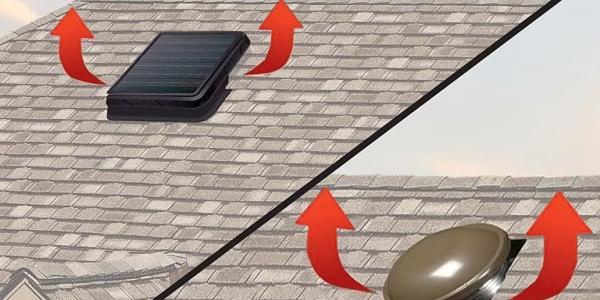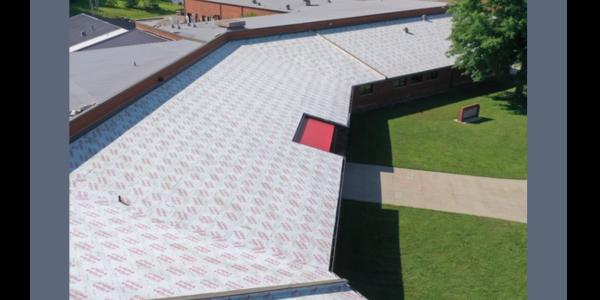Breathe easy with the right attic ventilation

By Dawn Killough, GAF.
Help your homeowners choose the best attic ventilation system for their home with GAF’s Master Flow™ product line.
Power attic ventilation systems offer a versatile solution to ensure enhanced airflow and temperature regulation in attics. GAF provides various options, including traditional hardwired and solar-powered vents to consider and compares the benefits and installation considerations for each type below. By leveraging the advanced features of GAF’s Master Flow™ product line, you can provide your customers with reliable and efficient ventilation solutions for their specific needs.
Power attic ventilation systems
Under the umbrella of powered attic ventilation systems, you have a few options to consider. Powered vents come in solar-powered and traditional hardwired versions, and they can be roof mounted or gable mounted. In order to stay efficient, most systems use a thermostat or combination thermostat/humidistat to trigger power attic fan operation — but it's worth digging a little deeper into how these systems differ.
Hardwired powered vents
Hardwired powered vents are connected directly to the house's electrical system via traditional electric (there are also convenient plug-in models as well), providing a consistent source of power. Fans come in a range of power levels depending on the level of air movement needed. For example, the GAF Master Flow ERV5 Roof Mount Power Attic Vent helps ventilate attics up to 2,200 square feet.
Solar-powered vent fans
Solar-powered fans are easy to install. They rely on a relatively small solar panel for power, making these vent fans a great option in areas with good exposure to the sun. Some solar-powered fans come with the option to connect to the home’s electrical system, allowing it to seamlessly switch between solar and house power. This helps to ensure that the fan has consistent access to power regardless of the conditions outside. GAF has a high-powered solar model in its Master Flow™ line as well as unique dual-powered models that switch automatically between solar and house power.
Roof mounted power vents
Power vents can be mounted on the roof surface, generally close to the ridge or to the highest part of the attic. Most roof vent fans have a low profile, but customers may want to have them installed on the back of the roof for aesthetic purposes. The GAF Master Flow ERV4 Roof Mount Power Attic Vent provides enough airflow for attics up to 1,600 square feet.
Gable mounted powered vents
Gable mounted vents are installed on the side wall of the attic. They come in both hardwired and solar options. Installed on the interior of the attic and with no exterior profile, the fans are easy to hide; the GAF Master Flow EGV5 Gable Mount Power Attic Vent is also an easy power vent to install.
Is it best to use electric or solar-powered attic vents?
Electric hardwired attic vents are a good option when there is limited exposure to the sun and for higher-powered fans. Hardwiring provides a consistent power source that doesn't depend on natural conditions. They’re still the most commonly installed types of power vents today.
Solar-powered attic vents are a good option when exposure to the sun is not an issue, and your project may not require a higher-powered fan. Overall, solar power vents work best in climates with less excessive heat or simply among customers who are looking for more environmentally friendly solutions. Regardless of what option you select, it's critical to ensure that the system is balanced with intake ventilation at or near the soffits.
How much does it cost to install a power vent?
Installation costs vary depending on the amount of work required and the number of fans needed. Some common costs include:
- Powered ventilator (cost may vary depending on the size and type)
- Penetrating the roof or side wall of house, if not already done (costs may vary)
- Installation labor (costs may vary)
- Wiring from vent location to the nearest electrical source (costs may vary)
- Making electrical connections (costs may vary)
- Exterior louver if gable mounted
Other options for attic ventilation
Other popular options for attic ventilation include static and mechanical vents. Static vents are openings that allow hot air to escape as air flows through the attic: air comes in from the intake vents at the lower level of the roof and rises to the top, where it exits through vents on the ridge or roof high point. The most common solutions being shingle-over ridge vents or roof louvers (i.e. slant-back or square top roof vents).
Mechanical vents rely on wind power to turn a turbine, which draws hot air from the attic to the outside. These fans rely on a fairly constant wind of at least 5-8 miles per hour to keep the air moving.
If you'd like more information about power attic ventilation design and options, visit the GAF Learning Portal. For attic ventilation products that keep your most critical needs in mind, consider the GAF Attic Ventilation product line.
Original article source: GAF
Learn more about GAF in their Coffee Shops Directory or visit www.GAF.com.





















Comments
Leave a Reply
Have an account? Login to leave a comment!
Sign In